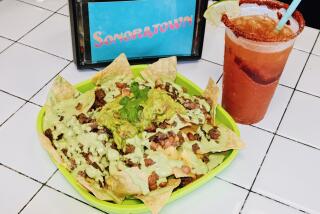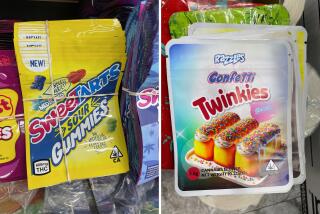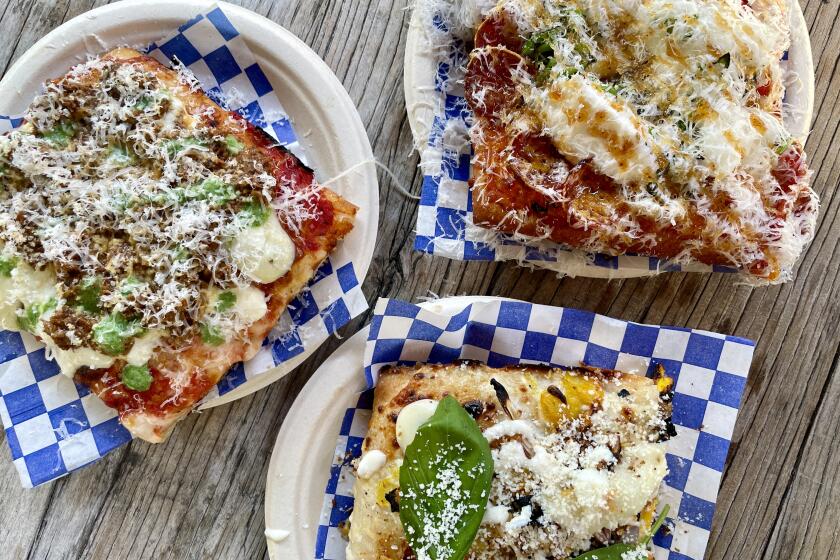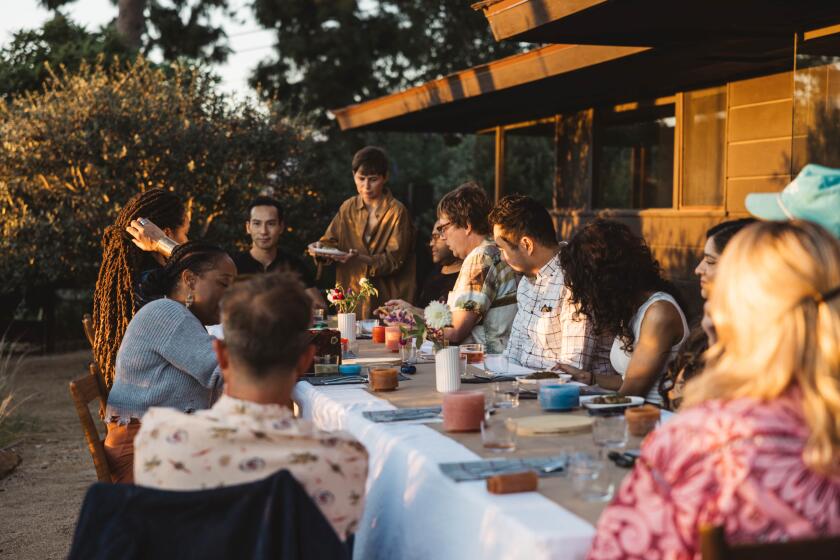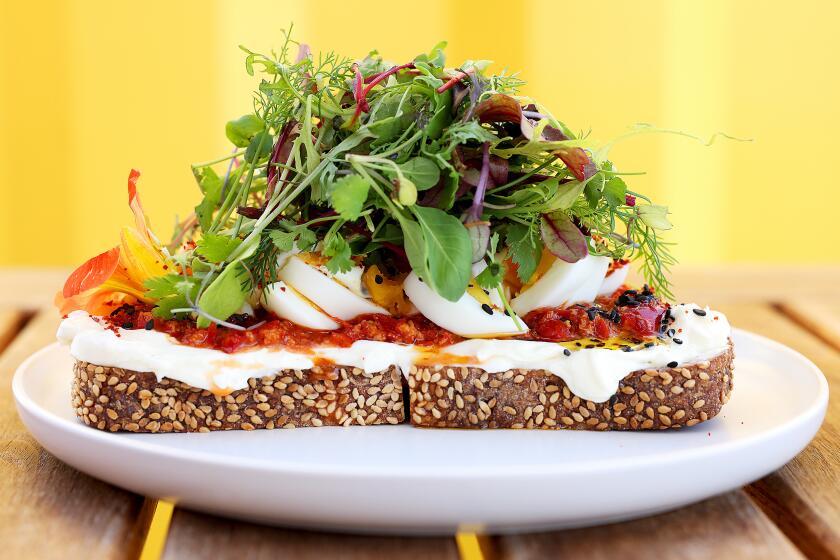Sweet surrender
IN chocolate circles, it’s often said that ganache reveals the true art of the chocolatier. Ganache, that creamy, silky, melt-in-your mouth blend of chocolate, cream and butter, is at the heart of many of the best artisan confections. And more and more these days, California chocolatiers are making outstanding ganaches — and pralines and caramels and butter creams — all covered in the most luscious chocolate.
Not so long ago, Californians — especially Southern Californians — might have had a hard time finding great fresh chocolates with coatings that snapped and ganaches that sang. Passionate chocoholics resorted to staking out a Teuscher store and waiting for the latest shipment from Switzerland, or tracking down a prepackaged box from La Maison du Chocolat at a high-end department store.
But now a growing number of chocolatiers from Sebastopol to San Diego are turning out impressive handcrafted chocolates. With distinguished pedigrees and a whopping enthusiasm for expensive, highest-quality ingredients, some of them rival top European confectioners. And best of all, their bonbons are fresh: There are several top-notch chocolatiers right here in Los Angeles, and many more in the Bay Area.
“More artisan confectioners are aspiring to a higher level of quality, and so much is changing right now in all aspects of chocolate making,” says Alice Medrich, who owned several Cocolat dessert stores in the Bay Area from 1976 to 1990 and is the author of several books on chocolate. “There’s a new level of detail, of care and attention during every step” of the process.
At Woodhouse Chocolate in Napa Valley, painstaking effort is poured into a tiny cup of dark chocolate layered with milk chocolate ganache, orange-blossom-scented fresh cream and marzipan infused with fiori di Sicilia, the citrus and vanilla extract traditionally used to flavor panettone. It’s hand-dipped into milk chocolate, topped with a clean swirl of dark chocolate and a speck of 24-karat gold leaf.
At Boule in West Hollywood, a square of thick ganache might be infused with raspberry and Earl Grey tea or with cardamom and coffee, all enrobed in silky chocolate. Bite into one and the chocolate snaps between your teeth, like good chocolate should, giving way to the velvety filling.
California’s artisan chocolatiers make their chocolates in small batches and meticulously cut or fill them piece by piece; they eschew preservatives or excessive amounts of sugar.
Their chocolates might be found in unexpected places, such as at humble pastry shop Frances in L.A.’s Little Tokyo district or at La Dolce V, in an antique mall outside of Sebastopol in Sonoma County. Other chocolatiers’ shops might be destinations in and of themselves, like Jin Patisserie’s Asian-inspired tea garden in Venice or the Recchiuti Confections store in San Francisco’s Ferry Building.
Buying local means getting the freshest chocolates possible — and there’s nothing like the experience of stepping into an artisan shop. The smell of chocolate fills the air, a chocolate tempering machine might be whirring in the back, and in a glass case out front are row after row of gorgeous bonbons. You get to pick exactly the flavors you want and know that these chocolates probably have been made within the last day or two.
*
Home-grown product
THE high-quality chocolate known as couverture that’s used by California confectioners often comes from European companies, such as Valrhona or Callebaut. But a California producer, Guittard Chocolate Co., is lately attracting a lot of attention.Founded in 1868 in San Francisco, Guittard, now based south of the city in Burlingame, features single-origin chocolate in its fairly new E. Guittard line of couverture. That means the cocoa beans all come from a particular region, such as Sur del Lago in Venezuela or Sambirano Valley in Madagascar.
The company wasn’t the first in California.
Ghirardelli Chocolate Co. was founded in 1852 in San Francisco, which offered a big port for the shipment of cocoa beans and a cool climate conducive to making and storing chocolate. Ghirardelli was first in California to make chocolate “from bean to bar,” in industry parlance. That is, from cocoa bean to the bars used by chocolatiers. Chocolatiers take the manufacturers’ product “from bar to bonbon.”
Chicago-based Blommer Chocolate Co. established its presence in the area in the 1950s. In October, renowned Swiss manufacturer Barry Callebaut opened a $20-million distribution facility in American Canyon in Napa Valley. The company is considering establishing a Chocolate Academy there, banking on the assumption that exciting things are happening on the West Coast.
But it was home-grown Scharffen Berger Chocolate Maker Inc., now based in Berkeley, that helped lead Californians toward darker chocolate. In 1996, Robert Steinberg, a physician, and John Scharffenberger, a former sparkling-wine maker, started in Steinberg’s kitchen with some cocoa beans, a coffee grinder, mortar and pestle, an electric mixer and a hair dryer, according to company lore.
At the time, Americans might already have been aware of premium dark chocolate such as the French brand Valrhona. Top New York chefs were listing it on their menus in the early ‘90s as an ingredient in their molten chocolate cakes. But Valrhona wasn’t as widely distributed at retail outlets in California as Scharffen Berger. (Now, however, retailers such as Trader Joe’s regularly stock Valrhona.) “We thought we’d be selling to restaurants, to food service. But we realized that consumers were eating it and cooking with it,” says Scharffenberger. At many retailers, he says, “We were the first [premium dark chocolate] on the store shelves . Others were available, but they weren’t making chocolate for the people.”
In a testament to a growing market for high-end dark chocolate, Hershey Co. bought Scharffen Berger last year.
While Southern California chocolatiers are the mavericks, experimenting with wild flavors in their fillings — lapsang souchong tea or pasilla chiles or kalamansi sour lime — Bay Area confectioners have long been setting standards.
Veteran chocolatier Richard Donnelly has been making chocolates by hand in his Santa Cruz shop since 1988. He studied confectionery in Switzerland and in France, including a stint with Robert Linxe, founder of La Maison du Chocolat. “Back when I started out, you could find good European chocolate. There was good stuff going to hotels and restaurants in San Francisco,” Donnelly says. “And there were the Cocolat stores. Otherwise, there wasn’t all that much when I opened.”
Much has happened since.
Michael Recchiuti and his wife, Jacky, started Recchiuti Confections in San Francisco in 1997. A box of Recchiuti’s confections might include a small, hand-cut square of thick, extra-bitter ganache, infused with tarragon, topped with a sliver of candied grapefruit peel, and enrobed in a thin layer of bittersweet chocolate.
These aren’t the kinds of chocolates that many Californians grew up with. See’s Candies started in Los Angeles in 1921, and their sticky fondants and sweet butter creams have long had their place in the hearts of many, but they’re the confections of a different era.
Bay Area chocolatiers have come a long way even since Joseph Schmidt set up shop in 1983 in San Francisco and popularized the “American truffle,” big, egg-shaped chocolates differentiated from more traditional confections by their bold, bright designs. (Hershey also has bought Joseph Schmidt.)
Jean-Marc and Casimira Gorce started XOX Truffles, also in San Francisco, in 1998. They were “scared that people wouldn’t like them. We thought people would expect them to be perfectly round,” Casimira Gorce says. Their truffles, unlike Schmidt’s perfectly formed chocolates, look like the actual truffles that come from the earth. They’re lumpy, and dusty with cocoa powder.
Other chocolatiers have emerged recently. Chuck Siegel launched Bay Area-based Charles Chocolates 16 months ago. Michael Mischer opened Michael Mischer Chocolates in Oakland in 2004.
Chocolatier Tracy Wood Anderson, and her husband, John Anderson, retired from the wine business and decided to make chocolates, opening Woodhouse Chocolate in St. Helena, Calif., in 2004. “People are just as fascinated with chocolate as they are about wine,” John Anderson says. “People in Napa know their wine, and now they’re getting into chocolate.”
Woodhouse is distinctive for its molded Belgian-style chocolates with lighter, fresh-cream fillings when many other chocolatiers prefer using ganache. Molded chocolates, recognizable by their intricate shapes and the patterns impressed in them, generally are more technically demanding to make than enrobed bonbons, which are dipped in melted chocolate. Woodhouse may be reintroducing an appreciation for molded chocolates with creamy whipped centers (you can’t enrobe a “fresh cream” because it would just disintegrate). As tastes shifted toward darker chocolates, these bonbons had fallen out of favor because their softer texture often demands use of lighter chocolates. It makes sense that ganache has been the filling of choice because it often requires a darker chocolate, with more cocoa content, and many connoisseurs still scoff at milk chocolate.
“As you get into higher-end chocolate, people make this assumption that because dark has the strongest flavor, it’s therefore the best,” Anderson says. “We don’t think that.”
But ganache is still the standard by which many chocolatiers are measured — and L.A. chocolatiers are measuring up.
*
Smoothing the way
MICHAEL BROCK stands at a work table over a bowl of melted chocolate at Boule in West Hollywood. Brock, who worked for Daniel Boulud and for Payard in New York, is the sous pastry chef currently overseeing patisserie and chocolates at owner Michelle Myers’ 1-year-old shop. He tempers the heated chocolate, cooling it with chunks of “seed chocolate.” When hardened, the chocolate should be smooth and without streaks.A lump of ganache is rolled into a ball and dipped by hand into the tempered chocolate. Then it’s rolled in cocoa, allowed to set, and the excess cocoa powder sifted from the truffle. “Nobody wants to inhale a huge puff of cocoa,” Brock says.
Brock and chocolatier Katy Monti estimate that they produce from 200 or 250 chocolates a day to as many as 800 a day in a busy season. That’s a tiny amount compared with an operation like See’s Candies, now based in South San Francisco, which makes as much as 175,000 pounds in a day. But making chocolates by hand — even the enrobed chocolates and truffles favored by L.A. chocolatiers — is extremely labor intensive.
When Kristy Choo opened Jin Patisserie in 2003, she says she cut all the ganache for her square chocolates with a knife, instead of a guitar, a device with stainless steel wires used to cut slabs of ganache into uniform pieces. “We were just starting, and I didn’t want to spend a lot on equipment. I did it that way for almost a year.”
At Jin, squares of ganache are dipped by hand. Decorations made from cocoa butter might be hand-painted or acetate transfers carefully affixed. Choo, from Singapore, uses Asian flavors in her ganaches: chrysanthemum, lemongrass, kalamansi sour lime, pandan — a leaf from the screw pine tree.
Other Southern Californians are pushing boundaries with their flavors, more so than their northern counterparts, for better or worse.
At Comparte’s in Brentwood, Jonathan Grahm is heading up chocolates at his family’s candy business, which has been around since 1950 selling stuffed dried fruit and chocolate-covered pretzels. The 21-year-old chocolatier has introduced ganache-based chocolates with flavors such as raspberry and pink peppercorn or jalapeño honeydew.
Michael Antonorsi, who started Chuao Chocolatier three years ago in Encinitas, says one of his most popular chocolates is filled with a raisin “fondue” and Napa Valley Cabernet caramel, spiced with pasilla chile and cayenne pepper. Antonorsi, who now has five stores in the San Diego area and one in Irvine, says he plans to open stores in L.A. in the next year or two.
At L’Artisan du Chocolat in Los Angeles, which operates out of Picholine Chocolatier’s storefront, Christian Alexandre and his wife, Whajung Park, have come up with about 60 flavors for their chocolates, including ginseng, tomato or kalamata olive.
Alexandre, who started the business about five years ago, says he competes for wholesale accounts with the likes of La Maison du Chocolat and Lenôtre. So can L.A.’s chocolatiers catch up to Europe’s? “We are still the cowboys,” says the Normandy-born Frenchman.
*
A fresh approach
ALL over the state, top confectioners are placing an ever higher premium on ingredients and freshness.It all starts with their couverture. These are labeled with percentages such as 85%, 72%, 60%, etc., which indicate the ratio of cocoa content to other ingredients, mainly sugar. The higher the percentage, the darker and less sweet the chocolate. “More important than the percentage of cocoa content is the quality of the bean itself,” says Donnelly.
Mischer of Oakland gets his couverture from a Swiss manufacturer — he won’t divulge the name. He says it’s made exclusively with the criollo bean from Venezuela, highly coveted because it represents less than an estimated 5% of the world’s cocoa crop. Mischer likes this single-origin chocolate because “it’s more about what happens in that growing area, with the soil and the weather.” Those phenomena show up in the chocolate’s “flavor characteristics.”
Just as much attention is being paid to other ingredients. (And consumers can expect to pay for it. These chocolates often cost more than $2 apiece.)
Mischer uses marzipan made by Central Valley almond growers and kirsch from St. George Spirits in Alameda, Calif.
Valerie Gordon of Valerie Confections in Los Angeles makes her chocolate-covered toffees with super-rich Plugra butter and ingredients such as fresh mint and organic almonds.
But what makes a great chocolate has as much to do with when it’s consumed as what’s been put in it.
“I make my chocolates fresh so that people will eat them fresh,” says Veronica Bowers, owner of La Dolce V. She says she uses butter and cream from Straus Family Creamery in western Marin County. “Their butter is the price of gold. There’s 85% butterfat content in their butter. It’s so thick and fat it’s almost chewy at room temperature. Their cream comes in a glass bottle and has an inch of butterfat on top.”
She says her chocolates have a shelf life of two weeks, if that.
“Freshness is the great dividing line,” author Medrich says. “Fresh ingredients are not consistent from season to season, from week to week, or even from day to day. And a craftsperson who oversees production, who remains close to production, can respond to those changes.”
Mischer’s chocolates are available only in six-piece or 12-piece packages — he says he keeps the packaging small because he wants people to eat his chocolates as soon as possible, and not leave them sitting around in a cupboard.
“I wanted to educate people, that you can go to a local store and get a fresh product, not buy something from Costco that was made months and months ago,” Mischer says. “People go to the farmers market for fresh produce and they go to the bakeries for bread. Chocolate can be the same way.”
*
(BEGIN TEXT OF INFOBOX)
A chocoholic’s glossary
Couverture: The technical name for the high-quality chocolate used to make confections and pastries, from the French couvrir, “to cover.”
Ganache: Couverture is added to boiled cream to make the filling for many confections. Butter also is often used in the mixture. The ganache may be flavored by infusing the cream with various ingredients.Single-origin, or varietal, couverture:
Chocolate for use by confectioners that is made with cocoa beans from a particular growing region — maybe from a specific county or even from one estate.Molded chocolates: Principally a Belgian technique in which a shell of chocolate is formed in a mold. A variety of fillings — butter cream, praline, caramel, ganache — can be poured or piped into the center. Then it’s closed with more chocolate.
Enrobed chocolates: Enrobing is a more common technique, the way many French chocolates are made. The center is often a ganache that is fairly firm and can stand up to being coated with melted chocolate. Often you can tell a chocolate is enrobed by looking at the bottom, which will be flat with some excess around the edges.
Truffles: Hand-rolled balls of ganache, sometimes dipped in chocolate, often rolled in cocoa powder.
— Betty Hallock
More to Read
Eat your way across L.A.
Get our weekly Tasting Notes newsletter for reviews, news and more.
You may occasionally receive promotional content from the Los Angeles Times.
